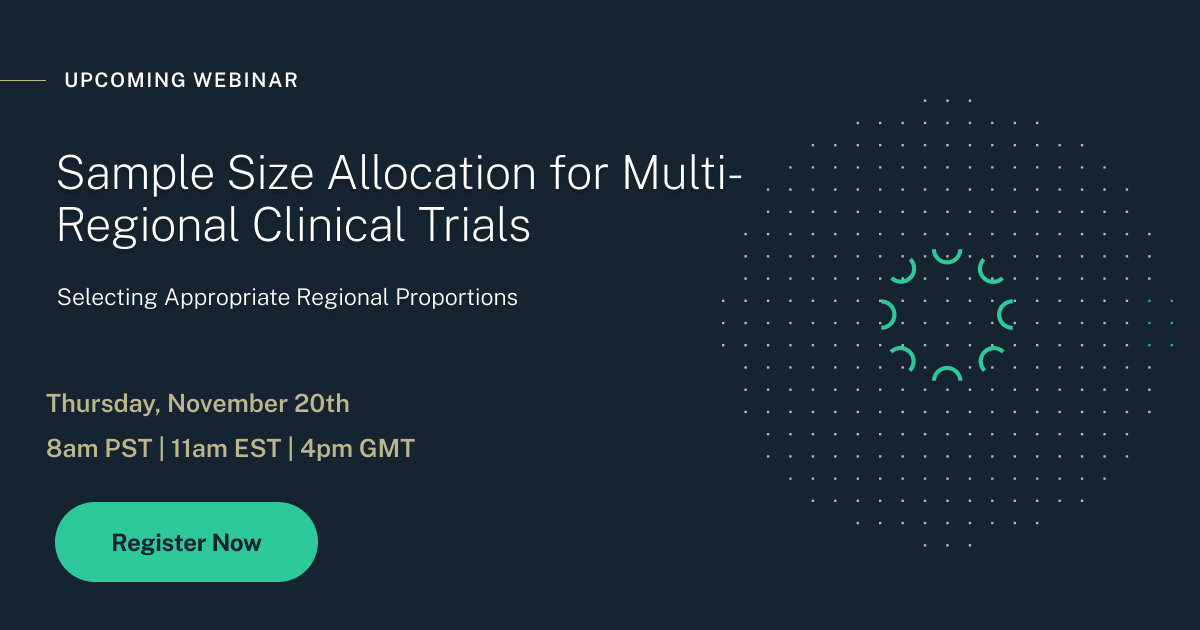A Guide to Sample Size for Pilot Studies
- T-Test Sample Size Calculation - Example 1 and 2. nqt
- Pilot Sample Size (Whitehead Overall Program) - Example 1 .nqt
- Pilot Sample Size (UCL Manual SD Calculation) - Example 1 .nqt
- Mean Difference Confidence Interval - Example 1 .nqt
- Internal Pilot Two Means - Example 2 .nqt
- Internal Pilot Two Proportions - Example 3 .nqt
- Case-Control Phase IV Study - Example 3 .nqt
- Internal Pilot Two Counts - Example 4 .nqt
- Problem Detection Example .nqt
- Internal Pilot Simulation Code .nqt
- CountOverdispersionTwo .csv
- CountNoOverdispersion .csv
- BlindedSSRNCT .csv
- BlindedSSR95UCL .csv
- BlindedSSR80UCL .csv
- 250PilotSDEqualOnePointTwoFive .csv
- CONSORT-extension-Pilot-and-Feasibility-Trials-Checklist .doc
Webinar Playback:
Sample Size for Pilot Studies
Maximising the value of pilot data
Pilot Studies are a common strategy to assess the feasibility of a study by previewing the expected outcome in a larger study. However, pilot studies are often too small and may often lead to suboptimal decision-making at the trial design stage.
In this tutorial, Ronan Fitzpatrick, Head of Statistics at nQuery will help you understand the impact of sample size on pilot study performance, land ook at the validity of common rules of thumb for pilot size and more formal approaches for sizing and integrating pilot studies.
Learning objectives of this webinar:
This tutorial will provide you with a comprehensive understanding of determining the appropriate sample sizes for pilot studies to enhance the reliability and efficiency of subsequent main trials. By the end of this webinar, you will be able to:
Key Areas Covered:
1. Understand the Purpose and Importance of Pilot Studies
-
Recognize the role of pilot studies in assessing feasibility and informing the design of larger trials.
-
Identify common challenges associated with insufficiently sized pilot studies, such as mis-specification of effect size or nuisance parameters.
2. Evaluate Common Rules of Thumb for Pilot Study Size
-
Examine traditional heuristics, like the "rule of 30," and their limitations in achieving pilot study objectives.
-
Understand why simple rules may lead to suboptimal decision-making in trial design.
3. Learn Formal Approaches for Sample Size Determination in Pilot Studies
-
Explore advanced methods that integrate pilot study objectives and design to calculate appropriate sample sizes.
-
Understand how to apply these methods to ensure pilot studies provide reliable data for main trial planning.
4. Explore Internal Pilot Designs for Blinded Sample Size Re-estimation
-
Learn about internal pilot designs that allow for sample size adjustments based on interim data without unblinding the study.
-
Understand how this approach can correct over-optimism in estimates of nuisance parameters, such as variance or overdispersion, during the planning stage.
Sample Size for Pilot Studies: A Quick guide for biostatisticians
Pilot study sample sizes are often based on simple rules of thumb such as the “rule of 30”. However, these heuristics have been evaluated to be inadequate to achieve the goal(s) of interest for a pilot study. Newer methods allow for the pilot study sample size to be calculated, which integrates the pilot study's objectives and design.
In addition, blinded adaptive design design provides an approach where a pilot study can be directly integrated into the full study. This improves power and ensures the pilot data can be easily utilised in the final analysis. For example, the internal pilot design for sample size re-estimation can adjust for over-optimism in the estimates for nuisance parameters such as the variance or overdispersion at the planning stage.
Understanding the Role of Pilot Studies
Pilot studies are not designed to test hypotheses but to provide critical information that informs the main study. They help estimate key parameters such as variance, effect size, and recruitment feasibility. A well-conducted pilot study reduces the risk of costly design flaws in the full trial while ensuring that assumptions about sample size and study logistics are realistic.
Determining Sample Size for Pilot Studies
Unlike full-scale trials, sample size in pilot studies is not based on traditional power calculations. Common rules of thumb, such as using a fixed number (e.g., 30 per group), are often insufficient. Instead, formal approaches consider the precision of variance estimates, expected effect size, and the study’s objectives. Biostatisticians must balance having enough participants to obtain meaningful preliminary data without overcommitting resources.
Internal Pilot Studies and Sample Size Re-estimation
Internal pilot studies allow researchers to adjust sample size estimates within a study without compromising integrity. These blinded re-estimations help refine nuisance parameters, such as variance estimates, and improve the accuracy of full-trial sample size calculations. Biostatisticians should consider this approach when planning studies where initial variance estimates are highly uncertain.
Best Practices for Biostatisticians
To maximize the value of pilot studies, biostatisticians should:
- Clearly define the study’s objectives, ensuring it aligns with the needs of the main trial.
- Use evidence-based methods rather than arbitrary rules to determine sample size.
- Consider internal pilot designs to allow for adaptive sample size modifications.
- Ensure transparent reporting of pilot study results, including limitations and data variability assessments.
About nQuery
nQuery helps make your clinical trials faster, less costly and more successful.
It is an end-to-end platform covering Frequentist, Bayesian, and Adaptive designs with 1000+ sample size procedures.
nQuery Solutions
Sample Size & Power Calculations
Calculate for a Variety of frequentist and Bayesian Design
Who is this for?
This will be highly beneficial if you're a biostatistician, scientist, or clinical trial professional that is involved in sample size calculation and the optimization of clinical trials in:
- Pharma and Biotech
- CROs
- Med Device
- Research Institutes
- Regulatory Bodies














